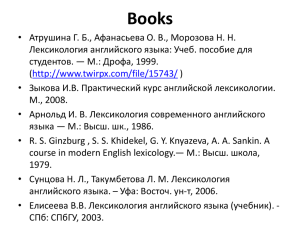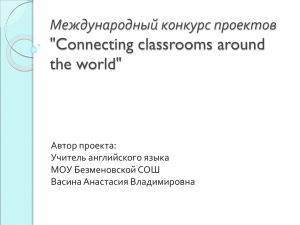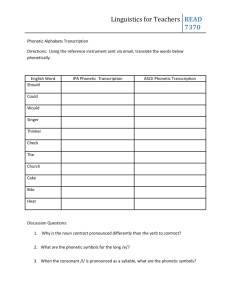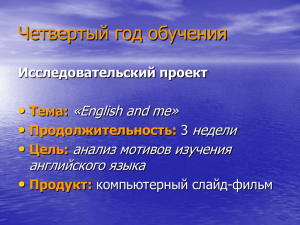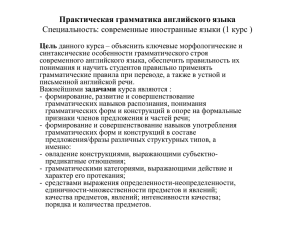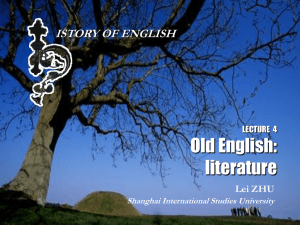Практические занятия по истории английского языка
advertisement
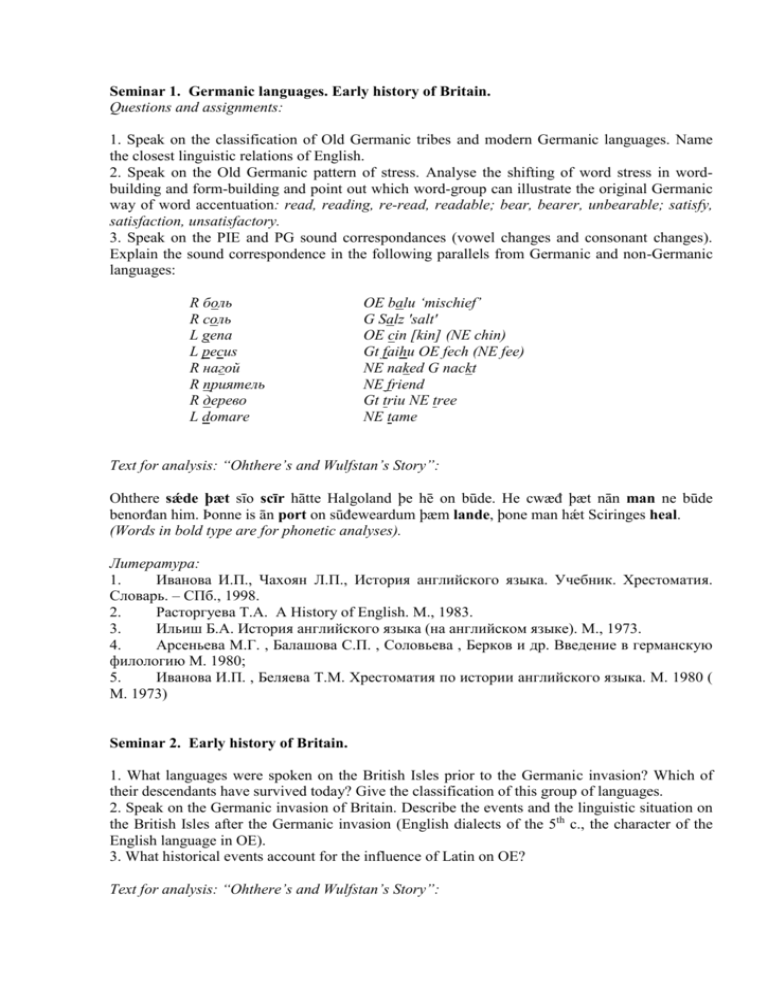
Seminar 1. Germanic languages. Early history of Britain.
Questions and assignments:
1. Speak on the classification of Old Germanic tribes and modern Germanic languages. Name
the closest linguistic relations of English.
2. Speak on the Old Germanic pattern of stress. Analyse the shifting of word stress in wordbuilding and form-building and point out which word-group can illustrate the original Germanic
way of word accentuation: read, reading, re-read, readable; bear, bearer, unbearable; satisfy,
satisfaction, unsatisfactory.
3. Speak on the PIE and PG sound correspondances (vowel changes and consonant changes).
Explain the sound correspondence in the following parallels from Germanic and non-Germanic
languages:
R боль
R соль
L gena
L pecus
R нагой
R приятель
R дерево
L domare
OE balu ‘mischief’
G Salz 'salt'
OE cin [kin] (NE chin)
Gt faihu OE fech (NE fee)
NE naked G nackt
NE friend
Gt triu NE tree
NE tame
Text for analysis: “Ohthere’s and Wulfstan’s Story”:
Ohthere sǽde þæt sīo scīr hātte Halgoland þe hē on būde. He cwæđ þæt nān man ne būde
benorđan him. Þonne is ān port on sūđeweardum þæm lande, þone man hǽt Sciringes heal.
(Words in bold type are for phonetic analyses).
Литература:
1.
Иванова И.П., Чахоян Л.П., История английского языка. Учебник. Хрестоматия.
Словарь. – СПб., 1998.
2.
Расторгуева Т.А. A History of English. М., 1983.
3.
Ильиш Б.А. История английского языка (на английском языке). М., 1973.
4.
Арсеньева М.Г. , Балашова С.П. , Соловьева , Берков и др. Введение в германскую
филологию М. 1980;
5.
Иванова И.П. , Беляева Т.М. Хрестоматия по истории английского языка. М. 1980 (
М. 1973)
Seminar 2. Early history of Britain.
1. What languages were spoken on the British Isles prior to the Germanic invasion? Which of
their descendants have survived today? Give the classification of this group of languages.
2. Speak on the Germanic invasion of Britain. Describe the events and the linguistic situation on
the British Isles after the Germanic invasion (English dialects of the 5th c., the character of the
English language in OE).
3. What historical events account for the influence of Latin on OE?
Text for analysis: “Ohthere’s and Wulfstan’s Story”:
Þyder he cwæđ þæt man mihte geseglian on ānum mōnđe, gyf man on niht wicode, and ælce
dæge hæfde ambyrne wind; and ealle đa hwīle hē sceal seglian be lande, and on þæt stēorbord
him biđ ǽrest Īraland, and þonne đā igland þe synd betux Īralande and þissum lande.
(Words in bold type are for phonetic analyses).
Литература:
1.
Иванова И.П., Чахоян Л.П., История английского языка. Учебник. Хрестоматия.
Словарь. – СПб., 1998.
2.
Расторгуева Т.А. A History of English. М., 1983.
3.
Ильиш Б.А. История английского языка (на английском языке). М., 1973.
4.
Арсеньева М.Г. , Балашова С.П. , Соловьева , Берков и др. Введение в германскую
филологию М. 1980;
5.
Иванова И.П. , Беляева Т.М. Хрестоматия по истории английского языка. М. 1980 (
М. 1973)
Seminar 3. Old English phonetics. Vowels.
Questions and assignments:
1. Did word stress in OE always fall on the first syllable? Recall some regular shifts of stress in
word-building and give similar examples fron present-day English.
2. Speak on the splitting of PG [a] and [a:] in OE and breaking and diphtongisation in Wessex
dialect in OE. Account for the difference between the vowels in OE þǽt, eal, monn, all going
back to PG words with [a] (Gt: þata , manna, alls). Account for the interchange of vowels in OE
dǽģe - dagas (NE day – Dat. Sg and Nom. Pl.); bǽđ
- bađian (NE bath,bathe).
3. Explain the term “mutation” and innumerate the changes referred to the mutations in Late PG
and in Early OE. Speak on i-umlaut and velar umlaut in OE. Give examples of vowel interchages
in the roots of related words in modern English that are results of i-umlaut.
Text for analysis: “Cura Pastoralis”
Ælfred kyning hāteđ grētan Wærfeđ biscep his wordum luflīce ond freondlīce ond đe cỳđan
hāte đæt mē com swīđe oft on gemynd, hwelce wiotan īu wǽron giond Angelcynn ǽgđer gē
godcundra hāda gē woruldcundra; ond hū gesæliglīca tīda đā wǽron giond Angelcynn; … (But
now there are very few learned men in England). (
(Words in bold type are for phonetic analysis).
Литература:
1.
Иванова И.П., Чахоян Л.П., История английского языка. Учебник. Хрестоматия.
Словарь. – СПб., 1998.
2.
Расторгуева Т.А. A History of English. М., 1983.
3.
Ильиш Б.А. История английского языка (на английском языке). М., 1973.
4.
Иванова И.П. , Беляева Т.М. Хрестоматия по истории английского языка. М. 1980 (
М. 1973)
Seminar 4. Old English phonetics. Consonants.
Questions and assignments:
1. Speak on the processes of voicing and devoicing of fricatives in OE and the phenomenon of
hardening. Define the sound values of the letters f, đ, s and comment on the system of OE
consonant phonemes: OE heofon, faran, ge-faran, hǽfde, offrung, ofer (NE heaven, fare,
had, offering, over); ođđe, ođer, Norđ, đanne (‘or’, other, North, then); sæ, wisse, cēosan,
cēas (NE sea, ‘knew’, choose, chose).
2. What consonant and vowel changes are illustrated by the following pairs of words:
Gt maiza
- ОЕ māra (NE more)
Gt kunþian
- ОE cyđan ('inform')
Gt dauþs
- OE dēad (NE dead)
Gt saljan
- OE sellan (NE sell)
OE þyncan
- OE þūhte (NE think.-thought)
OE mæġden
- mǽden (NE maiden)
Gt kinnus
- OE cinn (NS chin)
OHG isarn
- OE īren (NE iron)
Gt hausjan
- OE hīeren (NE hear)
Text for analysis: “Cura Pastoralis”
And ǣlc man đe wisdom lufađ, byđ ȝesǣliȝ, and sē đe nāđor nele ne leornian ne tǣcan, ȝyf he
mæȝ, þonne ācolađ his andȝyt fram đǣre hālȝan lāra, and hē ȝewit swā lytlum and lytlum fram
gode. Hwanon sceoldon cuman wīse lārēowas on godes folce, būton hī on juȝođe leornion?
(Ælfric’s Grammar. Introduction)
(Words in bold type are for phonetic analysis).
Литература:
1. Иванова И.П., Чахоян Л.П., История английского языка. Учебник. Хрестоматия.
Словарь. – СПб., 1998.
2.
Расторгуева Т.А. A History of English. М., 1983.
3.
Ильиш Б.А. История английского языка (на английском языке). М., 1973.
4.
Иванова И.П. , Беляева Т.М. Хрестоматия по истории английского языка. М. 1980
(1973)
Seminar 5. Old English Written Records and Poetry.
1. Runic inscriptions.
2. Old English manuscripts.
3. Speak on the Anglo-Saxon type of poetry.
Text for analysis: “Beowulf” (837-841. 863-868)
837-841: þā wæs on morgen,
mīne ȝefrǣȝe,
ymb đā ȝif-healle
gūđ-rinc moniȝ;
fērdon folc-toȝan
feorran ond nēa(ha)n
geond wīd-weȝas
wundor scēawian,
lāþes lastas.
863-368: Nē hīe hūru wine-drihten
wiht nē lōȝon,
glædne Hrōđgar,
ac þæt wæs gōd cyning.
Hwīllum heaþo-rōfe
hleapan lēton,
On ȝeflit faran
fealwe mēaras,
đǽr him fold-weȝas
fæȝere þūhton,
cystum cūđe;
hwīllum cyninges þeȝn,
guma ȝilp-hlæden,
ȝidda ȝemyndiȝ.
(Words in bold type are for phonetic analysis).
Литература:
1.
Иванова И.П., Чахоян Л.П., История английского языка. Учебник. Хрестоматия.
Словарь. – СПб., 1998.
2.
Расторгуева Т.А. A History of English. М., 1983.
3.
Ильиш Б.А. История английского языка (на английском языке). М., 1973.
4.
Иванова И.П. , Беляева Т.М. Хрестоматия по истории английского языка. М. 1980 (
М. 1973)
Seminar 6. Colloquium.
Text for analysis: “The old English Gospels”. Read and translate.
1. And eft æfter daȝum hē ēode into Cafarnaum, and hit wæs ȝe-hyred þæt hē wæs on
hūse.
2. And maneȝa toȝædere cōmon and hē tō hēom spræc.
3. And hī cōmon ānne laman tō him berende, þonne fēower men bǣron.
4. And þā hī nē mihton hine inbringan for þǣre maniȝu hī openodon þone hrōf þār sē
hǣlend wæs; and hī þā in-asendan þæt bed þē sē lama on læȝ.
5. Sōđlice đā sē hǣlend ȝeseah heora ȝelēafan, hē cwæđ to þām laman; Sunu, þē synt þīne
synna forȝyfene.
6. Þār wǣron sume of đām bōcerum sittende, and on heora heortum þencende.
7. Hwī spycđ þes þus, hē dyseȝađ; hwā mæȝ synna forȝyfan būton god āna.
8. Þā sē hǣlend þæt on his gāste oncnēow. Þæt hī swā betwux him þōhton, hē cwæđ tō
him; hwī đence ȝē þās đing on ēowrum heortan?
9. Hwæđer is eđre tō secgenne tō þām laman, þē synd đine synna forȝyfene, hwæđer þē
cweđan; āris, nim đīn bed ond gā.
10. Þæt ȝē sōđlīce witon þæt mannes sunu hæfđ anweald on eorđan synna tō forȝyfanne, hē
cwæđ tō þām laman.
11. Þē ic secge: āris, nim þīn bed, and gā tō þīnum hūse.
12. And hē sōna āras, and be-foran him eallum ēode; swā þæt ealle wundredon and þūs
cwǣden; nǣfre wē ǣr þyllic nē ȝesāwon.
13. Eft hē ūt eode tō đǣre sǣ, and eall sēo meniȝēo him tō com and hē hī lǣrde.
14. And þā hē forđ ēōde hē ȝe-seah Leuin Alphei sittende æt his cēp-setle, and hē cwæđ tō
him: folȝa mē, þā āras hē and folȝode him.
(Words in bold type are for phonetic analysis).
Seminar 7. Middle English and New English phonetics.
Questions and assignments:
1. Speak on the qualitative changes in monophthongs in EME. Prove, by instances of phonetic
changes, that ME was divided into a number of dialects.
2. Recall the development of [y] and [y:] and explain the differences in pronunciation and
spelling of merry, hill, busy, buy, evil, bury (all descending from OE words with short [y]) and
sleeve, fist, mice, sundry (descending from OE words with long [y:]).
3. Speak on the Great Vowel Shift. Point out some changes preceding the Great Vowel Shift
which display the same direction of evolution.
4. How could the vowels in OE talu, findan ultimately develop into diphthongs, though
originally they were short monophthongs (NE tale, find). Account for the vowel interchanges in
NE child-children, wild-wilderness, bewilder; behind-hindrance.
Text for analysis: “The Prologue”(“Canterbury Tales”)
Whan that Aprille with his shoures sote
The droghte of Marche hath perced to the rote
And bathed every veyne in swich licour,
Of which vertu engendred is the flour;
Whan Zephirus eek with his swete breeth
Inspired hath in every holt and heeth
The tendre croppes, and the yonge sonne
Hath in the Ram his halfe cours y-ronne,
And smalle fowles maken melodye.
That slepen al the night with open ye,
(So priketh hem nature in hir courages):
Than longen folk to goon on pilgrimages
And palmers for to seken straunge strondes
To ferne halwes, couthe in sondry londes;…
(Words in bold type are for phonetic analysis).
Литература:
1.
Иванова И.П., Чахоян Л.П., История английского языка. Учебник. Хрестоматия.
Словарь. – СПб., 1998.
2.
Расторгуева Т.А. A History of English. М., 1983.
3.
Ильиш Б.А. История английского языка (на английском языке). М., 1973.
4.
Иванова И.П. , Беляева Т.М. Хрестоматия по истории английского языка. М.
1980 ( М. 1973)
Seminar 8. Middle English and New English rules of reading.
1. What is meant by “discrepancy” between pronunciation and spelling in Mod. E? Give
examples of phonetic and conventional spelling. Prove that the written form of the word
usually lags behind its spoken form and indicates its earlier pronunciation.
2. *Reconstruct the phonetic changes so as to prove that the words have descended from a
single root: listen and loud, deep and depth, husband and house, foul and filth, long and length,
sheep and shepherd, tell, tale and talk, thief and theft, person and parson.
3. *Account for the mute letters in late, sight, wrong, often, bomb, autumn, course, knowledge,
honour, what, whole, guest, pneumonia, psalm.
Text for analysis: ”The vision of Piers Plowman”:
In a sommer seson
whan soft was the sonne,
I shope me in shroudes
as I shepe were,
In habite as an heremite
vnholy of workes,
Went wyde in this world
wondres to here.
Ac on a May mornynge
on Maluerne hulles,
Me byfel a ferly
of fairy, me thoughte;
I was very forwandred
and went me to reste
Vnder a brode banke
bi a bornes side,
And as I lay and lened
and loked in the wateres,
I slombred in a sleping
it sweyued so merye.
(Words in bold type are for phonetic analysis).
Литература:
1.
Иванова И.П., Чахоян Л.П., История английского языка. Учебник. Хрестоматия.
Словарь. – СПб., 1998.
2.
Расторгуева Т.А. A History of English. М., 1983.
3.
Ильиш Б.А. История английского языка (на английском языке). М., 1973.
4.
Иванова И.П. , Беляева Т.М. Хрестоматия по истории английского языка. М.
1980 ( М. 1973)
Seminar 9. Middle English and Early New English
Text for analysis: ”The Prologue”(“Canterbury Tales”)
And specially, from every shires ende
Of Engelond, to Canterbure they wende,
The holy blissful martir for to seke,
That hem hath holpen, whan that they were seke
Bifel that, in that seson on a day,
In Southwerk at the Tabard as I lay
Redy to wenden on my pilgrimage
To Caunterbury with ful devout corage,
At night was come in-to that hostelrye
Wel nyne and twenty in a companye,
Of sondry folk, by aventure y-falle
In felawshipe, and pilgrims were they alle,
That toward Caunterbury wolden ryde;
The chambers and the stables weren wyde,
And wel we weren esed ate beste
And shortly, whan the sonne was to reste,
So hadde I spoken with hem everichon,
That I was of hir felowshipe anon,
And made forward erly for to ryse,
To take our way ther as I yow devyse.
(Words in bold type are for phonetic analysis).
Seminar 10. Colloquium.


